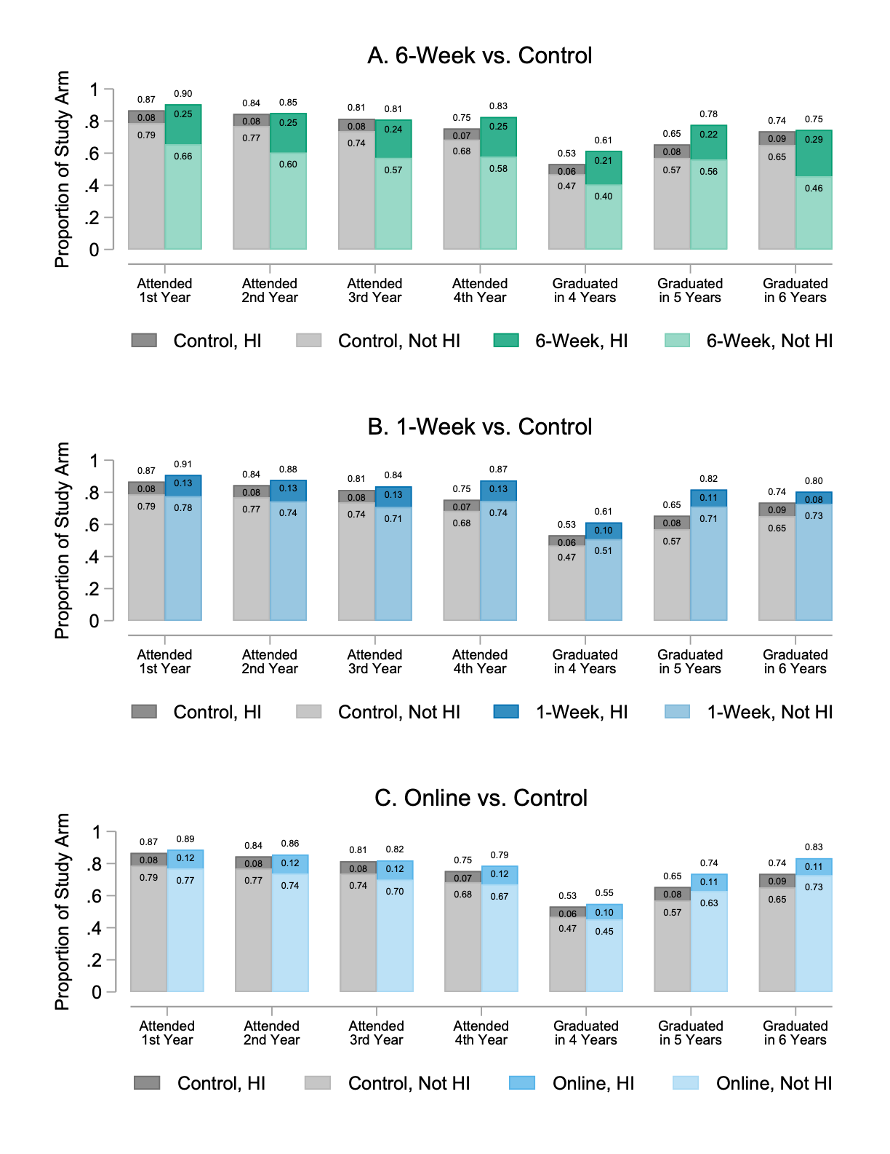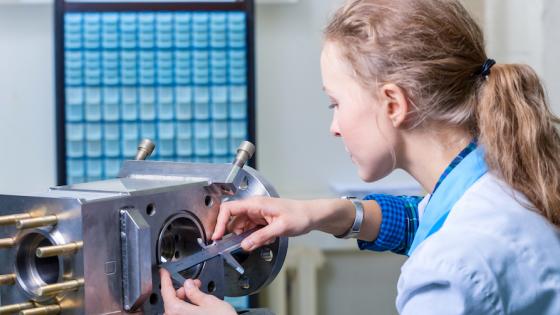Black and Hispanic workers are underrepresented in the high-wage, college degree-holding STEM – science, technology, engineering, and mathematics – workforce in the US (National Science Board 2021). This under-representation contributes to racial and ethnic wage gaps (Altonji et al. 2016, Campbell et al. 2022). Under-representation in the STEM workforce is preceded by disparities in who attains a college degree in STEM. About 9% of STEM bachelor’s degrees went to Black students and 16% to Hispanic students despite these groups representing 14% and 21% percent of the college-age population in the US, respectively (National Science Board 2022). The disparity in STEM degrees is not due to differences in interest. Upon entering college, underrepresented minority students plan to major in STEM fields at similar rates to their White peers, but they are more likely to switch away from a STEM field or leave college (Riegle-Crumb et al. 2019). Given that STEM preparation and college access are shaped prior to college entrance, STEM-focused enrichment programmes for high school students are promising vehicles to reduce disparities in STEM degree attainment. However, we know little about the efficacy of such STEM pipeline programmes.
Three STEM summer pipeline programmes
In a recent paper (Cohodes et al. 2022), we study the effectiveness of a trio of such pipeline programmes targeted to rising high school seniors from groups historically underrepresented in STEM fields. Hosted at an elite technical institution in the US (the ‘host institution’, or HI), the programmes differed in their modality and intensity: (1) six weeks full-time on-site, (2) one week full-time on-site, or (3) six months with periodic meetings online. The six-week programme was held on the HI campus and offered a shortened version of the HI’s freshman curriculum, along with college counselling, field trips, introductions to role models in STEM fields, and a college-like living experience. The one-week version of the programme offered a short, intensive course in a STEM field and an abbreviated version of other aspects of the six-week program. Finally, the online version of the programme offered a six-month engagement in STEM enrichment activities, with online speakers and interactions and a short ‘conference’ visit to the HI campus over the summer.
Main findings
After an initial screening for suitability for the programmes, the programme administration office offered admission based on a modified random assignment design. Each application was ranked by a selection committee. The highest ranked applicants were put into a randomisation pool in which they were randomly assigned between the three programmes. The next group of students were put into a separate randomisation pool where they were randomly assigned to the online programme or a control group. The presence of the online programme in both groups serves as a link that allows us to compare students in all programmes to the control condition, and we also account for the regional priorities and separate lotteries by gender that were used in the randomisation process. Thus, our treatment effect estimates show the effect of the programme compared to a highly accomplished control group of similar applicants. We show impacts on college enrolment and graduation at four-year colleges, split between the host institution and other colleges in Figure 1.
Figure 1 The impact of STEM summer assignment on four-year college attendance and graduation
Students offered seats in the programme were slightly more likely to attend college, but the difference was not statistically significant. However, the type of college attended changed, with students enrolling in the most selective institutions, including the HI, at higher rates. The six-week programme increased enrolment at elite institutions by 17 percentage points, the one-week programme induced a 14 percentage point shift to elite colleges, and the online programme boosted elite enrolment by 10 percentage points. These increases were large compared to the 49% rate of enrolment in elite institutions for the control group. Both students offered seats in the programme and those in the control group maintained similar rates of college enrolment in the first three years of college, but in the fourth year of college differences began to emerge.
In the fourth year of college, admission to a summer programme increased enrolment at any four-year college. The differences in enrolment reflect a combination of control group students dropping out, taking time off, or delaying college progress, with the declines in enrolment coming from outside of the host institution. The effects of the summer programme persist into college graduation.
Only 53% of control group students graduate from a four-year college in four years. This is higher than the US four-year graduation rate of 45.3% (US Department of Education 2020), but it is low considering the students in this sample have near-perfect GPAs and standardised test scores two standard deviations above the country-wide mean. Both the six-week and one-week programmes increase the likelihood that a student graduates from any four-year institution within four years by about 8 percentage points, and the online programme has a positive, but not statistically significant, impact as well.
For five-year graduation, the STEM summer programmes maintain or increase their gains relative to the control group (however, these estimates reflect one less cohort). Control group graduation rates increase over time, but all three programmes make it more likely that a student graduates with a degree within five years. Graduation gains come both from the host institution and other elite colleges.
One of the stated goals of the programmes is to increase the proportion of underrepresented students in STEM careers, and a key part of the STEM pipeline is completing a major in a STEM field. Despite strong interest in STEM and high academic achievement, only 37% of the control group graduate with a STEM degree within four years. The six-week programme increased four-year STEM degree receipt by 13 percentage points; the difference is even larger in five-year degree attainment rates, where the STEM degree shift is 20 percentage points. The one-week and online programmes also increased STEM degree attainment rates within five years, with shifts of 15 and 5 percentage points, respectively. We estimate that the shift to STEM degrees increased potential earnings by 2–6%.
Why did the programmes work?
We explore several explanations for why the programmes might increase college quality, graduation, and STEM degrees. Given that gains in college graduation almost exactly parallel the changes in graduation expected based on the college completion rates of the institutions in which the participants enrol, we conclude that programme-induced shifts toward attending more selective colleges with higher graduation rates are the largest factor in the increases in college persistence and graduation that we document. Our survey evidence demonstrates that the programmes increase students’ knowledge of the college application process and encourage more sophisticated college application strategies. We also explored the role of subject matter knowledge, confidence, and signalling via survey data and other analyses and found little scope for them to explain our findings.
Discussion
This analysis shows that targeted programmes to increase diversity on college campuses can have wide-ranging benefits for participants. Our findings also shed light on the optimal time to intervene to support a diverse STEM pipeline; federal investment in STEM fields is targeted to students while they attend college or graduate school, not earlier. Focusing on higher education after students apply to college may miss a key opportunity to intervene in students’ lives before they apply to college – a point in time crucial to the institutional choices that may ultimately help students succeed.
The results we summarise here also highlight the importance of college quality in students’ graduation. Colleges can influence whether a student graduates, their choice of major, and future employment and earnings (Hoekstra 2009, Cohodes and Goodman 2014, Zimmerman 2014, Brown et al. 2015, Goodman et al. 2017, Zimmerman 2018, Chetty et al. 2020, Bleemer 2021). With increased access to elite colleges being a key pathway for the effectiveness of the STEM summer programmes, our findings underscore the importance of college quality and make salient that declines in state funding support for higher education may have far-reaching consequences for students who do not have access to well-resourced postsecondary options.
References
Altonji, J G, P Arcidiacono, and A Maurel (2016), “The Analysis of Field Choice in College and Graduate School: Determinants and Wage Effects”, in E A Hanushek, S Machin, and L Woessmann (eds), Handbook of the Economics of Education, Volume 5, Elsevier.
Bleemer, Z (2021), “Top percent policies and the return to postsecondary selectivity”, unpublished manuscript.
Brown, J, C Fang and F Gomes (2015), “US university degrees: High cost, high reward”, VoxEU.org, 13 March.
Campbell, S, L Macmillan, R Murphy and G Wyness (2022), “Inequalities in student to degree match”, VoxEU.org, 13 February.
Chetty, R, J N Friedman, E Saez, N Turner, and D Yagan (2020), “Income segregation and intergenerational mobility across colleges in the United States”, The Quarterly Journal of Economics 135(3): 1567–1633.
Cohodes, S R and J S Goodman (2014), “Merit aid, college quality, and college completion: Massachusetts’ Adams scholarship as an in-kind subsidy”, American Economic Journal: Applied Economics 6(4): 251–85.
Cohodes, S R, H Ho and S C Robles (2022), “STEM Summer Programs for Underrepresented Youth Increase STEM Degrees”, NBER Working Paper 30227.
Goodman, J, M Hurwitz and J Smith (2017), “Access to 4-year public colleges and degree completion”, Journal of Labor Economics 35(3): 829-867.
Hoekstra, M (2009), “The effect of attending the flagship state university on earnings: A discontinuity-based approach”, The Review of Economics and Statistics 91(4): 717–724.
National Science Board (2021), “The STEM labor force of today: Scientists, engineers and skilled technical workers: Science and engineering indicators 2021”, NSB-2021-2, National Science Foundation, Arlington, VA.
National Science Board (2022), “Higher education in science and engineering: Science and engineering indicators 2022”, NSB-2022-3, National Science Foundation, Arlington, VA.
Riegle-Crumb, C, B King, and Y Irizarry (2019), “Does STEM stand out? Examining racial/ethnic gaps in persistence across postsecondary fields”, Educational Researcher 48(3): 133–144.
US Department of Education (2020), Digest of Education Statistics 2020, Table 326.10, National Center for Education Statistics.
Zimmerman, S D (2014), “The returns to college admission for academically marginal students”, Journal of Labor Economics 32(4): 711–754.
Zimmerman, S (2018), “How elite universities shape upward mobility into top jobs and top incomes”, VoxEU.org, 8 October.







